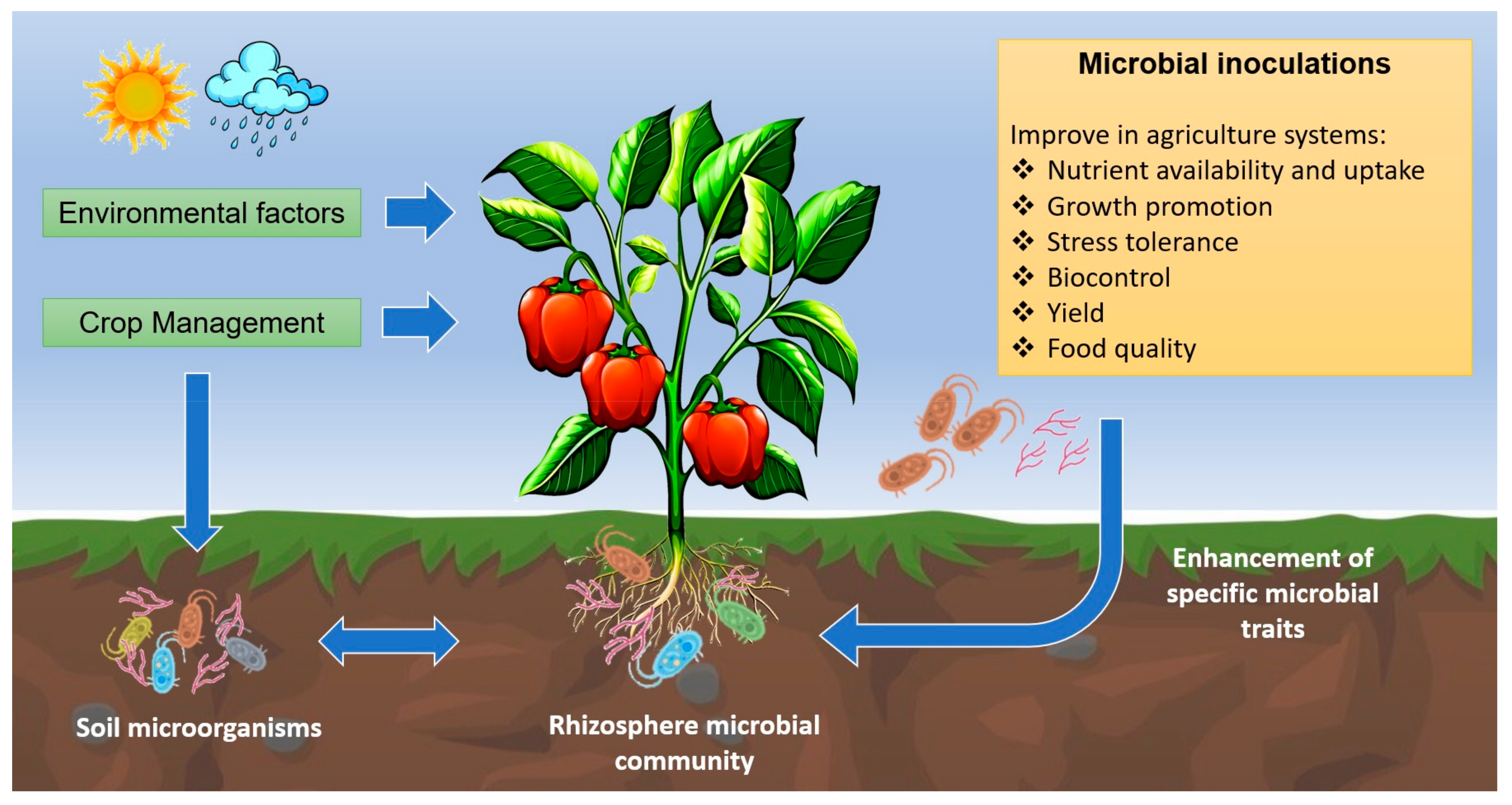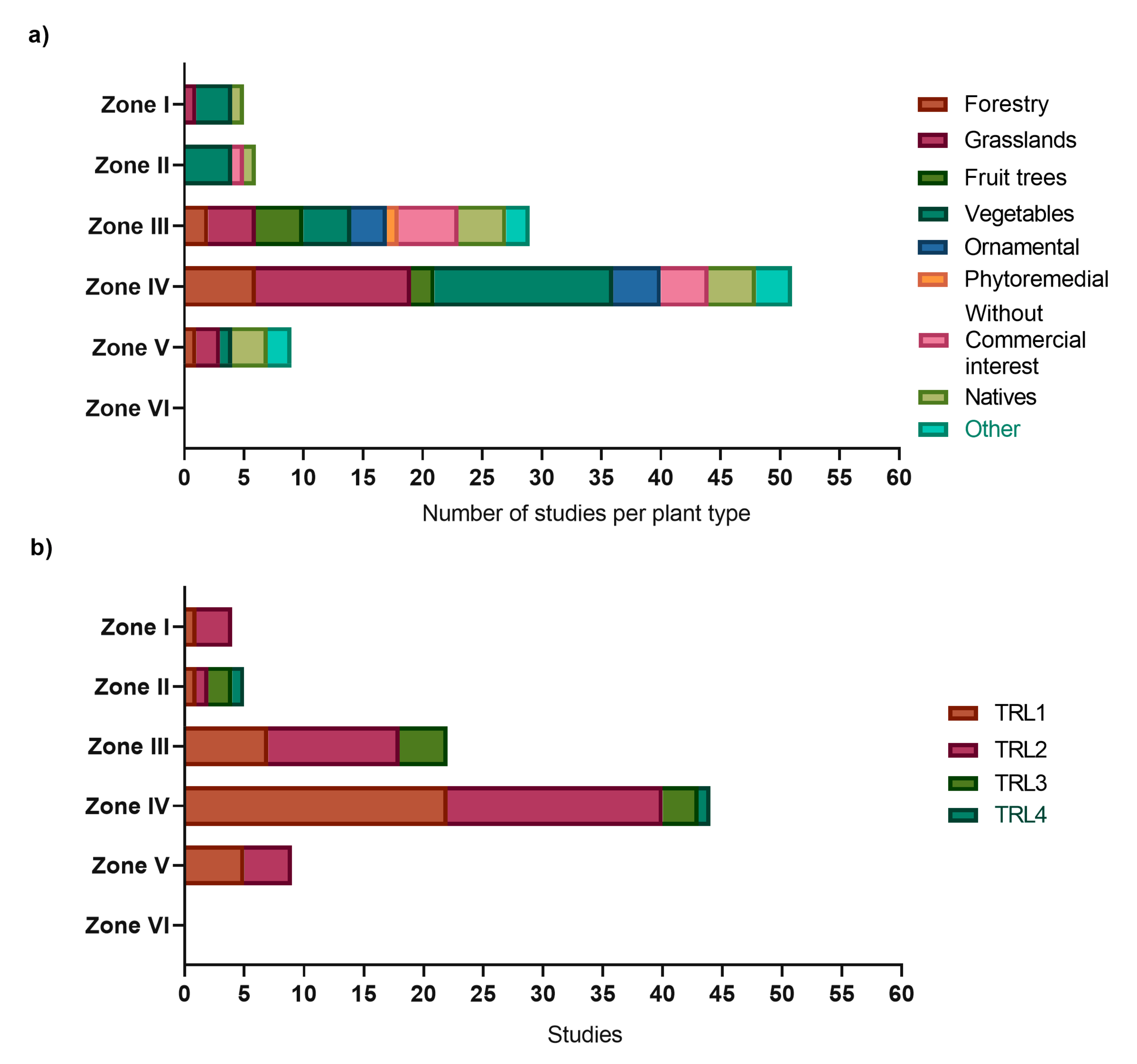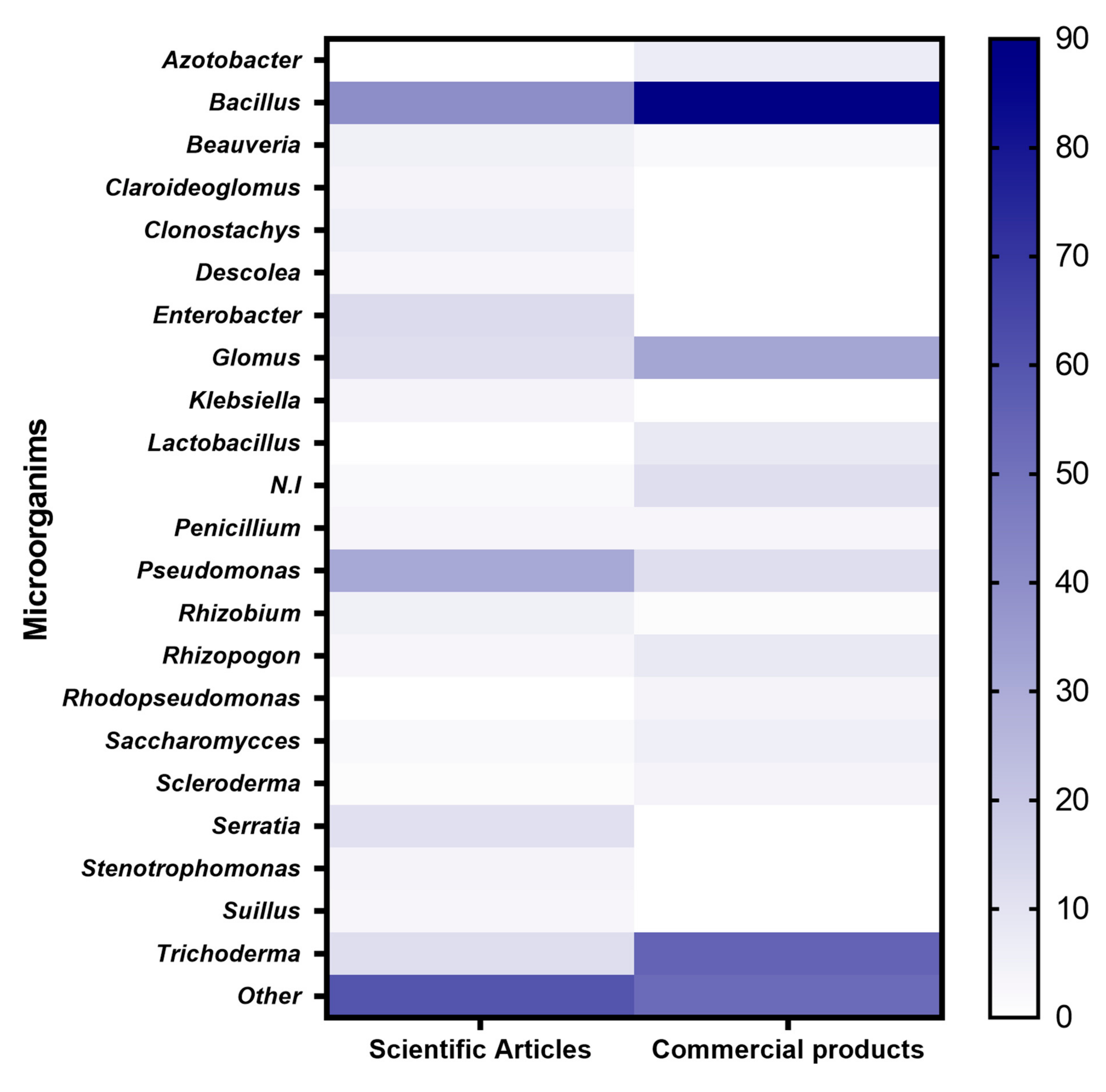Challenges for Plant Growth Promoting Microorganism Transfer from Science to Industry: A Case Study from Chile
Abstract
1. Introduction
2. Materials and Methods
2.1. Study Case
2.2. Search Strategy for Scientific Publications
2.3. Selection of Scientific Publications
2.4. Meta-Analysis
- (1)
- Type of PGP mechanism: here, we distinguished 7 PGPM mechanisms (phosphate solubilization, N fixation, siderophores production, phytohormones production, ACC-deaminase activity, exopolysaccharides production, biocontrol capacity), as well as the category “others” for all other reported mechanisms.
- (2)
- Type of environmental stress: here, we distinguished pH, nutrient deficit, salinity, drought, pollution, temperature (heat or cold), UV radiation, altitude, herbivory, fire, and others.
- (3)
- Inoculated plant type (vegetable, grass, fruit tree, etc.).
- (4)
- Technology Readiness Level (TRL) [16].
- (5)
- Strain identity.
2.5. Database of Microorganisms Available for the Chilean Agricultural Sector
3. Plant-Microorganism Interaction in Chile: A Case Study
3.1. General Overview of Plant-Microorganism Interaction in Chile
3.2. Reduction of Environmental Stress through Inoculation of Microorganisms
3.3. Towards a Biotechnological Solution
4. Gaps in Knowledge and Technology Transfer of PGPM Research
4.1. Inter- and Transdisciplinary Research
4.2. Territories, Public Policy and Society
4.3. Collaborative Innovation between Academia and Industry
5. Final Remarks
Supplementary Materials
Author Contributions
Funding
Data Availability Statement
Acknowledgments
Conflicts of Interest
References
- Díaz-Rodríguez, A.M.; Salcedo Gastelum, L.A.; Félix Pablos, C.M.; Parra-Cota, F.I.; Santoyo, G.; Puente, M.L.; Bhattacharya, D.; Mukherjee, J.; de los Santos-Villalobos, S. The Current and Future Role of Microbial Culture Collections in Food Security Worldwide. Front. Sustain. Food Syst. 2021, 4, 291. [Google Scholar] [CrossRef]
- Valverde, C.; Ramírez, C.; Kloepper, J.W.; Cassán, F. Current Research on Plant-Growth Promoting Rhizobacteria in Latin America: Meeting Report from the 2nd Latin American PGPR Workshop. J. Plant Growth Regul. 2015, 34, 215–219. [Google Scholar] [CrossRef]
- Vishwakarma, K.; Kumar, N.; Shandilya, C.; Mohapatra, S.; Bhayana, S.; Varma, A. Revisiting Plant–Microbe Interactions and Microbial Consortia Application for Enhancing Sustainable Agriculture: A Review. Front. Microbiol. 2020, 11, 3195. [Google Scholar] [CrossRef] [PubMed]
- Lee, S.K.; Lur, H.S.; Liu, C. te From Lab to Farm: Elucidating the Beneficial Roles of Photosynthetic Bacteria in Sustainable Agriculture. Microorganisms 2021, 9, 2453. [Google Scholar] [CrossRef]
- Anand, U.; Vaishnav, A.; Sharma, S.K.; Sahu, J.; Ahmad, S.; Sunita, K.; Suresh, S.; Dey, A.; Bontempi, E.; Singh, A.K.; et al. Current Advances and Research Prospects for Agricultural and Industrial Uses of Microbial Strains Available in World Collections. Sci. Total Environ. 2022, 842, 156641. [Google Scholar] [CrossRef]
- Kumar, S.; Diksha; Sindhu, S.S.; Kumar, R. Biofertilizers: An Ecofriendly Technology for Nutrient Recycling and Environmental Sustainability. Curr. Res. Microb. Sci. 2022, 3, 100094. [Google Scholar] [CrossRef]
- Backer, R.; Rokem, J.S.; Ilangumaran, G.; Lamont, J.; Praslickova, D.; Ricci, E.; Subramanian, S.; Smith, D.L. Plant Growth-Promoting Rhizobacteria: Context, Mechanisms of Action, and Roadmap to Commercialization of Biostimulants for Sustainable Agriculture. Front. Plant. Sci. 2018, 871, 1473. [Google Scholar] [CrossRef] [PubMed]
- Verma, M.; Mishra, J.; Arora, N.K. Plant Growth-Promoting Rhizobacteria: Diversity and Applications. Environ. Biotechnol. Sustain. Future 2019, 6, 129–173. [Google Scholar] [CrossRef]
- Koskey, G.; Mburu, S.W.; Awino, R.; Njeru, E.M.; Maingi, J.M. Potential Use of Beneficial Microorganisms for Soil Amelioration, Phytopathogen Biocontrol, and Sustainable Crop Production in Smallholder Agroecosystems. Front. Sustain. Food Syst. 2021, 5, 130. [Google Scholar] [CrossRef]
- Shah, A.; Nazari, M.; Antar, M.; Msimbira, L.A.; Naamala, J.; Lyu, D.; Rabileh, M.; Zajonc, J.; Smith, D.L. PGPR in Agriculture: A Sustainable Approach to Increasing Climate Change Resilience. Front. Sustain. Food Syst. 2021, 5, 211. [Google Scholar] [CrossRef]
- Alori, E.T.; Babalola, O.O. Microbial Inoculants for Improving Crop Quality and Human Health in Africa. Front. Microbiol. 2018, 9, 2213. [Google Scholar] [CrossRef]
- Basu, A.; Prasad, P.; Das, S.N.; Kalam, S.; Sayyed, R.Z.; Reddy, M.S.; Enshasy, H. el Plant Growth Promoting Rhizobacteria (PGPR) as Green Bioinoculants: Recent Developments, Constraints, and Prospects. Sustainability 2021, 13, 1140. [Google Scholar] [CrossRef]
- Aguilera, J.M.; Larraín, F. Natural Laboratories in Emerging Countries and Comparative Advantages in Science: Evidence from Chile. Rev. Policy Res. 2021, 38, 732–753. [Google Scholar] [CrossRef]
- Sarricolea, P.; Herrera-Ossandon, M.; Meseguer-Ruiz, Ó. Climatic Regionalisation of Continental Chile. J. Maps 2017, 13, 66–73. [Google Scholar] [CrossRef]
- Santibáñez, F.; Santibáñez, P.; Caroca, C.; González, P. Atlas Agroclimático de Chile; Universidad de Chile: Santiago, Chile, 2017. [Google Scholar]
- Armstrong, K. Emerging Industrial Applications. In Carbon Dioxide Utilisation: Closing the Carbon Cycle: First Edition; Elsevier: Amsterdam, The Netherlands, 2015; pp. 237–251. [Google Scholar] [CrossRef]
- Black, J.S.; Salto-Tellez, M.; Mills, K.I.; Catherwood, M.A. The Impact of next Generation Sequencing Technologies on Haematological Research—A Review. Pathogenesis 2015, 2, 9–16. [Google Scholar] [CrossRef]
- Zhang, J.; Chiodini, R.; Badr, A.; Zhang, G. The Impact of Next-Generation Sequencing on Genomics. J. Genet. Genom. 2011, 38, 95–109. [Google Scholar] [CrossRef] [PubMed]
- Martínez-Tilleria, K.; Núñez-Ávila, M.; León, C.A.; Pliscoff, P.; Squeo, F.A.; Armesto, J.J. A Framework for the Classification Chilean Terrestrial Ecosystems as a Tool for Achieving Global Conservation Targets. Biodivers. Conserv. 2017, 26, 2857–2876. [Google Scholar] [CrossRef]
- Zambrano, F.; Vrieling, A.; Nelson, A.; Meroni, M.; Tadesse, T. Prediction of Drought-Induced Reduction of Agricultural Productivity in Chile from MODIS, Rainfall Estimates, and Climate Oscillation Indices. Remote Sens. Environ. 2018, 219, 15–30. [Google Scholar] [CrossRef]
- Cai, W.; Cowan, T.; Thatcher, M. Rainfall Reductions over Southern Hemisphere Semi-Arid Regions: The Role of Subtropical Dry Zone Expansion. Sci. Rep. 1948, 2, 702. [Google Scholar] [CrossRef]
- Censal, C. ¿En Qué Etapa Del Post-Censo Estamos? Primeros Resultados Definitivos Entrega Completa de Resultados Definitivos Entrega de Base de Microdatos. Available online: http://www.censo2017.cl/wp-content/uploads/2017/12/Presentacion_Resultados_Definitivos_Censo2017.pdf (accessed on 9 March 2023).
- Gaete, A.; Mandakovic, D.; González, M. Isolation and Identification of Soil Bacteria from Extreme Environments of Chile and Their Plant Beneficial Characteristics. Microorganisms 2020, 8, 1213. [Google Scholar] [CrossRef]
- Viale, M.; Bianchi, E.; Cara, L.; Ruiz, L.E.; Villalba, R.; Pitte, P.; Masiokas, M.; Rivera, J.; Zalazar, L. Contrasting Climates at Both Sides of the Andes in Argentina and Chile. Front. Environ. Sci. 2019, 7, 69. [Google Scholar] [CrossRef]
- Maldonado, S.; Rodríguez, A.; Ávila, B.; Morales, P.; González, M.P.; Araya Angel, J.P.A.; Olalde, V.; Bravo, J.; Jana, C.; Sierra, C.; et al. Enhanced Crop Productivity and Sustainability by Using Native Phosphate Solubilizing Rhizobacteria in the Agriculture of Arid Zones. Front. Sustain. Food Syst. 2020, 4, 607355. [Google Scholar] [CrossRef]
- Fortt, J.; González, M.; Paloma, M.; Remonsellez, F.; Coba de la PeñA, T.; Ostra-Gallardo, E.; Stoll, A. Bacterial Modulation of the Plant Ethylene Signaling Pathway Improves Tolerance to Salt Stress in Lettuce (Lactuca sativa L.). Front. Sustain. Food Syst. 2022, 6, 70. [Google Scholar] [CrossRef]
- Salvatierra-Martinez, R.; Sepúlveda Chavera, G.; Huanca Mamani, W.; Rodríguez Molina, M. Native Strains of Trichoderma from Northern Chile: Adaptive Tolerance in Boric Saline Soils. Interciencia 2015, 40, 263–269. [Google Scholar]
- Vurukonda, S.S.K.P.; Vardharajula, S.; Shrivastava, M.; SkZ, A. Enhancement of Drought Stress Tolerance in Crops by Plant Growth Promoting Rhizobacteria. Microbiol. Res. 2016, 184, 13–24. [Google Scholar] [CrossRef] [PubMed]
- FAO Climate Change and Food Security: Risks and Responses. 2015. Available online: https://www.fao.org/3/i5188e/I5188E.pdf (accessed on 9 March 2023).
- Carlson, R.; Tugizimana, F.; Steenkamp, P.A.; Dubery, I.A.; Hassen, A.I.; Labuschagne, N. Rhizobacteria-Induced Systemic Tolerance against Drought Stress in Sorghum bicolor (L.) Moench. Microbiol. Res. 2020, 232, 126388. [Google Scholar] [CrossRef]
- Fahad, S.; Bajwa, A.A.; Nazir, U.; Anjum, S.A.; Farooq, A.; Zohaib, A.; Sadia, S.; Nasim, W.; Adkins, S.; Saud, S.; et al. Crop Production under Drought and Heat Stress: Plant Responses and Management Options. Front. Plant Sci. 2017, 8, 1147. [Google Scholar] [CrossRef]
- GOSWAMI, M.; DEKA, S. Plant Growth-Promoting Rhizobacteria—Alleviators of Abiotic Stresses in Soil: A Review. Pedosphere 2020, 30, 40–61. [Google Scholar] [CrossRef]
- Kampers, L.F.C.; Asin-Garcia, E.; Schaap, P.J.; Wagemakers, A.; Martins dos Santos, V.A.P. Navigating the Valley of Death: Perceptions of Industry and Academia on Production Platforms and Opportunities in Biotechnology. EFB Bioeconomy J. 2022, 2, 100033. [Google Scholar] [CrossRef]
- Boisier, J.P.; Alvarez-Garreton, C.; Cordero, R.R.; Damiani, A.; Gallardo, L.; Garreaud, R.D.; Lambert, F.; Ramallo, C.; Rojas, M.; Rondanelli, R. Anthropogenic Drying in Central-Southern Chile Evidenced by Long-Term Observations and Climate Model Simulations. Elementa 2018, 6, 74. [Google Scholar] [CrossRef]
- Naamala, J.; Smith, D.L. Relevance of Plant Growth Promoting Microorganisms and Their Derived Compounds, in the Face of Climate Change. Agronomy 2020, 10, 1179. [Google Scholar] [CrossRef]
- Lobo, C.B.; Juárez Tomás, M.S.; Viruel, E.; Ferrero, M.A.; Lucca, M.E. Development of Low-Cost Formulations of Plant Growth-Promoting Bacteria to Be Used as Inoculants in Beneficial Agricultural Technologies. Microbiol. Res. 2019, 219, 12–25. [Google Scholar] [CrossRef]
- Dolmans, S.A.M.; Walrave, B.; Read, S.; van Stijn, N. Knowledge Transfer to Industry: How Academic Researchers Learn to Become Boundary Spanners during Academic Engagement. J. Technol. Transf. 2021, 47, 1422–1450. [Google Scholar] [CrossRef]
- Baglieri, D.; Baldi, F.; Tucci, C.L. University Technology Transfer Office Business Models: One Size Does Not Fit All. Technovation 2018, 76–77, 51–63. [Google Scholar] [CrossRef]
- Sarker, A.; Ansary, M.W.R.; Hossain, M.N.; Islam, T. Prospect and Challenges for Sustainable Management of Climate Change-Associated Stresses to Soil and Plant Health by Beneficial Rhizobacteria. Stresses 2021, 1, 200–222. [Google Scholar] [CrossRef]
- Vassilev, N.; Vassileva, M.; Martos, V.; Garcia del Moral, L.F.; Kowalska, J.; Tylkowski, B.; Malusá, E. Formulation of Microbial Inoculants by Encapsulation in Natural Polysaccharides: Focus on Beneficial Properties of Carrier Additives and Derivatives. Front. Plant Sci. 2020, 270. [Google Scholar] [CrossRef] [PubMed]
- Borge, L.; Bröring, S. Exploring Effectiveness of Technology Transfer in Interdisciplinary Settings: The Case of the Bioeconomy. Creat. Innov. Manag. 2017, 26, 311–322. [Google Scholar] [CrossRef]
- Domino, S.E.; Smith, Y.R.; Johnson, T.R.B. Opportunities And Challenges of Interdisciplinary Research Career Development: Implementation of A Women’s Health Research Training Program. J. Womens Health 2007, 16, 256–261. [Google Scholar] [CrossRef]
- Moallemi, E.A.; Malekpour, S.; Hadjikakou, M.; Raven, R.; Szetey, K.; Ningrum, D.; Dhiaulhaq, A.; Bryan, B.A. Achieving the Sustainable Development Goals Requires Transdisciplinary Innovation at the Local Scale. One Earth 2020, 3, 300–313. [Google Scholar] [CrossRef]
- OECD Improving Knowledge Transfer and Collaboration between Science and Business in Spain | OECD Science, Technology and Industry Policy Papers|OECD ILibrary. Available online: https://www.oecd-ilibrary.org/science-and-technology/improving-knowledge-transfer-and-collaboration-between-science-and-business-in-spain_4d787b35-en (accessed on 8 March 2023).
- Forbat, J. Opportunities and Challenges to Increase Inter- and Transdisciplinarity: A Qualitative Study of the FloodRISE Project. J. Multidiscip. Eval. 2020, 16, 32–47. [Google Scholar] [CrossRef]
- Vásquez-Dean, J.; Maza, F.; Morel, I.; Pulgar, R.; González, M. Microbial Communities from Arid Environments on a Global Scale. A Systematic Review. Biol. Res. 2020, 53, 1–12. [Google Scholar] [CrossRef]
- Guerra, C.A.; Heintz-Buschart, A.; Sikorski, J.; Chatzinotas, A.; Guerrero-Ramírez, N.; Cesarz, S.; Beaumelle, L.; Rillig, M.C.; Maestre, F.T.; Delgado-Baquerizo, M.; et al. Blind Spots in Global Soil Biodiversity and Ecosystem Function Research. Nat. Commun. 2020, 11, 1. [Google Scholar] [CrossRef] [PubMed]
- Thompson, L.R.; Sanders, J.G.; McDonald, D.; Amir, A.; Ladau, J.; Locey, K.J.; Prill, R.J.; Tripathi, A.; Gibbons, S.M.; Ackermann, G.; et al. A Communal Catalogue Reveals Earth’s Multiscale Microbial Diversity. Nature 2017, 551, 457–463. [Google Scholar] [CrossRef] [PubMed]
- Zhang, Y.; Tariq, A.; Hughes, A.C.; Hong, D.; Wei, F.; Sun, H.; Sardans, J.; Peñuelas, J.; Perry, G.; Qiao, J.; et al. Challenges and Solutions to Biodiversity Conservation in Arid Lands. Sci. Total Environ. 2023, 857, 159695. [Google Scholar] [CrossRef] [PubMed]
- Patelli, A.; Napolitano, L.; Cimini, G.; Gabrielli, A. Geography of Science: Competitiveness and Inequality. J. Informetr. 2023, 17, 101357. [Google Scholar] [CrossRef]
- Peterson, E.W.F. The Role of Population in Economic Growth. Sage Open 2017, 7, 2158244017736094. [Google Scholar] [CrossRef]
- Millennium Ecosystem Assessment. Ecosystems and Human Well-being: Desertification Synthesis; World Resources Institute: Washington, DC, USA, 2005; 36p, Available online: https://www.millenniumassessment.org/documents/document.354.aspx.pdf (accessed on 25 February 2023).
- Surana, K.; Singh, A.; Sagar, A.D. Strengthening Science, Technology, and Innovation-Based Incubators to Help Achieve Sustainable Development Goals: Lessons from India. Technol. Forecast Soc. Chang. 2020, 157, 120057. [Google Scholar] [CrossRef]
- Dehmer, S.P.; Pardey, P.G.; Beddow, J.M.; Chai, Y. Reshuffling the Global R&D Deck, 1980–2050. PLoS ONE 2019, 14, e0213801. [Google Scholar] [CrossRef]
- OECD/UN Production Transformation Policy Review of Chile Reaping the Benefits of New Frontiers. 2018. Available online: https://www.oecd.org/publications/production-transformation-policy-review-of-chile-9789264288379-en.htm (accessed on 9 March 2023).
- Demblans, A.; Martínez, M.P.; Lavalle, C. Place-Based Solutions to Territorial Challenges: How Policy and Research Can Support Successful Ecosystems. Sci. Policy Handb. 2020, 19, 224–238. [Google Scholar] [CrossRef]
- Fatton, M.; Schneiter, A.; Allisiardi, M.; Hänni, L.; Hauser, G.; Gonçalves-Fernandes, Y.; Pessina, A.; Pijnenburg, M.-L.; Vaudroz, C.; Bshary, A.; et al. Microbes Go to School: Using Microbiology and Service-Learning to Increase Science Awareness and Fostering the Relationship Between Universities and the General Public. Front. Educ. 2021, 6, 371. [Google Scholar] [CrossRef]
- Stark, L.A. Beneficial Microorganisms: Countering Microbephobia. CBE Life Sci. Educ. 2010, 9, 387–389. [Google Scholar] [CrossRef] [PubMed]
- Timmis, K.; Cavicchioli, R.; Garcia, J.L.; Nogales, B.; Chavarría, M.; Stein, L.; McGenity, T.J.; Webster, N.; Singh, B.K.; Handelsman, J.; et al. The Urgent Need for Microbiology Literacy in Society. Environ. Microbiol. 2019, 21, 1513–1528. [Google Scholar] [CrossRef] [PubMed]
- Klerkx, L.; Jakku, E.; Labarthe, P. A Review of Social Science on Digital Agriculture, Smart Farming and Agriculture 4.0: New Contributions and a Future Research Agenda. NJAS—Wagening. J. Life Sci. 2020, 90–91, 100315. [Google Scholar] [CrossRef]
- Azagra-Caro, J.M.; Barberá-Tomás, D.; Edwards-Schachter, M.; Tur, E.M. Dynamic Interactions between University-Industry Knowledge Transfer Channels: A Case Study of the Most Highly Cited Academic Patent. Res. Policy 2017, 46, 463–474. [Google Scholar] [CrossRef]
- Pinto, P.E.; Vallone, A.; Honores, G. The Structure of Collaboration Networks: Findings from Three Decades of Co-Invention Patents in Chile. J. Informetr. 2019, 13, 100984. [Google Scholar] [CrossRef]
- Saviano, M.; Barile, S.; Farioli, F.; Orecchini, F. Strengthening the Science–Policy–Industry Interface for Progressing toward Sustainability: A Systems Thinking View. Sustain. Sci. 2019, 14, 1549–1564. [Google Scholar] [CrossRef]
- Franzoni, C.; Sauermann, H. Crowd Science: The Organization of Scientific Research in Open Collaborative Projects. Res. Policy 2014, 43, 1–20. [Google Scholar] [CrossRef]





Disclaimer/Publisher’s Note: The statements, opinions and data contained in all publications are solely those of the individual author(s) and contributor(s) and not of MDPI and/or the editor(s). MDPI and/or the editor(s) disclaim responsibility for any injury to people or property resulting from any ideas, methods, instructions or products referred to in the content. |
© 2023 by the authors. Licensee MDPI, Basel, Switzerland. This article is an open access article distributed under the terms and conditions of the Creative Commons Attribution (CC BY) license (https://creativecommons.org/licenses/by/4.0/).
Share and Cite
Muñoz-Carvajal, E.; Araya-Angel, J.P.; Garrido-Sáez, N.; González, M.; Stoll, A. Challenges for Plant Growth Promoting Microorganism Transfer from Science to Industry: A Case Study from Chile. Microorganisms 2023, 11, 1061. https://doi.org/10.3390/microorganisms11041061
Muñoz-Carvajal E, Araya-Angel JP, Garrido-Sáez N, González M, Stoll A. Challenges for Plant Growth Promoting Microorganism Transfer from Science to Industry: A Case Study from Chile. Microorganisms. 2023; 11(4):1061. https://doi.org/10.3390/microorganisms11041061
Chicago/Turabian StyleMuñoz-Carvajal, Eduardo, Juan Pablo Araya-Angel, Nicolás Garrido-Sáez, Máximo González, and Alexandra Stoll. 2023. "Challenges for Plant Growth Promoting Microorganism Transfer from Science to Industry: A Case Study from Chile" Microorganisms 11, no. 4: 1061. https://doi.org/10.3390/microorganisms11041061
APA StyleMuñoz-Carvajal, E., Araya-Angel, J. P., Garrido-Sáez, N., González, M., & Stoll, A. (2023). Challenges for Plant Growth Promoting Microorganism Transfer from Science to Industry: A Case Study from Chile. Microorganisms, 11(4), 1061. https://doi.org/10.3390/microorganisms11041061





